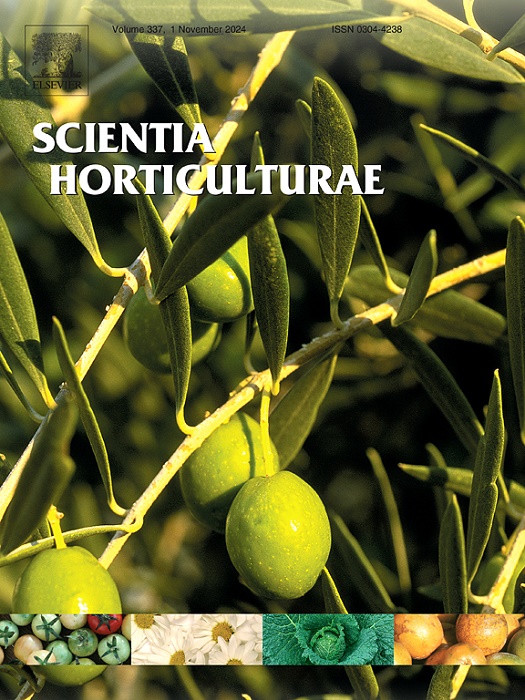Differential responses of microstructure, antioxidant defense, and plant hormone signaling regulation in potato (Solanum tuberosum L.) under drought, alkaline salt, and combined stresses
IF 3.9
2区 农林科学
Q1 HORTICULTURE
引用次数: 0
Abstract
In the arid and semi-arid zones of Northwest China, soil drought and alkaline salt stress often occur simultaneously and affect plant growth at multiple levels. Potato (Solanum tuberosum L.) is a food crop sensitive to drought and alkaline salt stresses and is susceptible to yield loss due to environmental impacts. In recent years, most of the research on abiotic stress response in potato has focused on drought and saline single stresses, and the mechanism of potato response to combined drought-alkaline salt stress and its interactions are still unclear. Therefore, a pot experiment was designed in this study and the potato variety 'Atlantic' was selected as the test material. The effects of drought (25 % PEG-6000), alkaline salt (200 mmol·L-1 NaHCO3) and combined drought-alkaline salt (25 % PEG-6000 + 200 mmol·L-1 NaHCO3) stresses on growth traits, micro- and ultrastructure, reactive oxygen species, osmoregulatory substances, and antioxidant defenses of potato were investigated using no stress (CK) as a control, leaf photosynthesis and endogenous plant hormones, and also analyzed the changes in the expression patterns of genes related to plant hormone signal transduction under different stresses. The results showed that drought, alkaline salt, and combined stress affected growth, leaf anatomy, and photosynthesis, and increased the accumulation of osmoregulatory substances in potato. The scavenging activities of antioxidant compounds and antioxidant enzymes were enhanced in potato, and combined stress treatments significantly damaged potato more than single stresses. In 2022, combined stress caused a marked increase in H2O2 (208.7 %) and O2-(455.6 %) content, while in 2023, they increased by 87.5 % and 215.7 %, respectively. SOD, POD, CAT, TPX, APX, GR, GPX and DHAR enzyme activities were increased by 209.13 %, 55.19 %, 152.59 %, 47.13 %, 104.02 %, 347.37 %, 68.45 % and 130.69 % in 2022 compared to CK in the combined stress treatment. In 2023, they increased by 229.81 %, 49.95 %, 160.62 %, 102.16 %, 94.06 %, 505.15 %, 47.00 %, and 121.19 %, respectively. After the stress treatments, the contents of gibberellic acid (GA3) and auxins (IAA) were significantly lower than those in CK, whereas the contents of abscisic acid (ABA), salicylic acid (SA), and brassinosteroids (BRs) increased. Expression of IAA-related genes (AUX1, Aux/IAA, GH3, and SAUR) was up-regulated after stress. ABA-related genes (PYR/PYL, SnRK2, and ABF) were up-regulated after stress, whereas protein phosphatase 2C (PP2C) genes were down-regulated in expression after stress. The GA3 receptor GID1 and the F-box protein GID2 were up-regulated after stress. Xyloglucosyl transferase TCH4 gene was up-regulated by stress and positively correlated with changes in BRs content. The TGA transcription factor, PR-1 gene, was induced to up-regulate its expression by stress and positively correlated with changes in SA content. Drought, alkaline salt, and combined stress reduced potato tuber yield and quality, which were 54.13 % and 60.14 % lower than CK in combined stress treatments in 2022 and 2023, respectively, which were significantly correlated with changes in physiological and biochemical characteristics and hormone contents of potato plants.

求助全文
约1分钟内获得全文
求助全文
来源期刊

Scientia Horticulturae
农林科学-园艺
CiteScore
8.60
自引率
4.70%
发文量
796
审稿时长
47 days
期刊介绍:
Scientia Horticulturae is an international journal publishing research related to horticultural crops. Articles in the journal deal with open or protected production of vegetables, fruits, edible fungi and ornamentals under temperate, subtropical and tropical conditions. Papers in related areas (biochemistry, micropropagation, soil science, plant breeding, plant physiology, phytopathology, etc.) are considered, if they contain information of direct significance to horticulture. Papers on the technical aspects of horticulture (engineering, crop processing, storage, transport etc.) are accepted for publication only if they relate directly to the living product. In the case of plantation crops, those yielding a product that may be used fresh (e.g. tropical vegetables, citrus, bananas, and other fruits) will be considered, while those papers describing the processing of the product (e.g. rubber, tobacco, and quinine) will not. The scope of the journal includes all horticultural crops but does not include speciality crops such as, medicinal crops or forestry crops, such as bamboo. Basic molecular studies without any direct application in horticulture will not be considered for this journal.
 求助内容:
求助内容: 应助结果提醒方式:
应助结果提醒方式:


